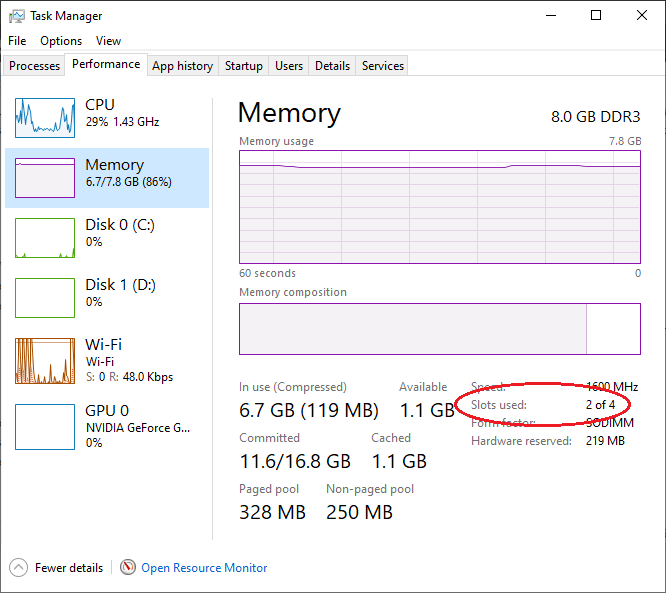Slots used: 2 of 2 Form factor: DIMM Hardware reserved: 4.4 GB Available 2.0 GB Cached 1.7 GB Committed 1.8/7.2 GB Paged pool 211 MB Non-paged pool 96.5 MB In use (Compressed) 1.5 GB (42.7 MB).

When a user wants to add or upgrade memory (RAM) in a computer, they need to know how many memory slots are available. The following section will help you to determine the number of memory slots in your computer, as well as how many are currently being used.
Windows Task Manager
The easiest solution for Windows users is to open the Windows Task Manager.
- Press the Windows key, type Task Manager, and then press Enter.
- In the window that appears, click the Performance tab (A), then select Memory (B).
- In the lower-right corner, the number of slots is displayed in the Slots used: section (C).
- As you can see, this computer has a total of four memory slots, although only two are currently being utilized.
Use the CPU-Z utility
Another way to get information about memory slots and details about the RAM currently installed on your computer, is to use the free CPU-Z third-party utility.
- Open an Internet browser and visit the CPUID website.
- On the left side of the screen, select your operating system.
- On the next page, select your preferred language.
- On the next screen, click the DOWNLOAD NOW! button.
- Once the download has finished, install it from your browser and open the program.
- Click the SPD tab at the top of the screen, and then click the down arrow in the Memory Slot Selection section.
- As you can see in the image above, all of the memory slots (in this case, four) are listed in the drop-down menu.
If you select a different slot from the drop-down menu, CPU-Z will tell you additional information about the RAM that is installed, or nothing if the slot is unoccupied.
What Does 1 Of 2 Ram Slots Used Mean
Examine the motherboard
Sometimes the best way to determine the available memory slots is to open the computer and examine the motherboard. Opening the computer is the best option if were unable to get the Windows Task Manager or CPU-Z to work.
Looking inside the case, the motherboard is the primary large circuit board. On most motherboards, the memory slots are located on either side of the CPU, and resemble what is shown below.
Most computer motherboards have two, three, or four memory slots. Some higher-end motherboards have as many as eight. The motherboard in the picture above has no memory modules installed in any of its three slots.
NoteIf your computer has no memory slots available and you want to upgrade, you must remove and replace some of the existing memory.
Additional information
- See our memory definition for further information and related links.
A memory slot, memory socket, or RAM slot is what allows RAM (computer memory) to be inserted into the computer. Most motherboards have two to four memory slots, which determine the type of RAM used with the computer. The most common types of RAM are SDRAM and DDR for desktop computers and SODIMM for laptop computers, each having various types and speeds. The picture below is an example of what memory slots may look like inside a desktop computer. In this picture, there are three open and available slots for three memory sticks.
When buying a new computer or motherboard, pay close attention to the types of RAM the memory slots can accept. Make sure you know exactly type of RAM to buy for your computer. It is also important to note how many available memory slots are available in your computer. It is not uncommon for computers to have all memory slots occupied. If all slots are full and you want to upgrade the computer memory, you need to remove some or all of the existing memory.
Related pages
Memory module, Memory terms